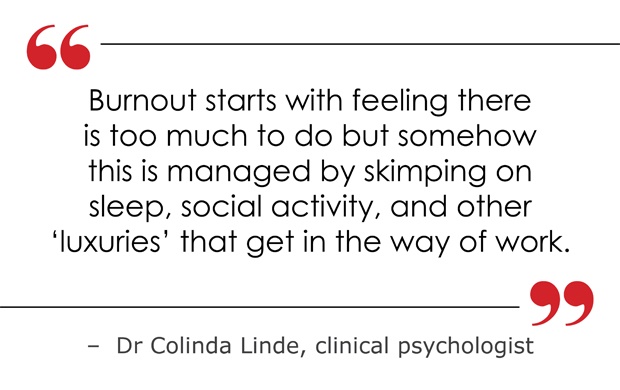
If you check your pay slip, you should see a number that indicates the amount of leave days you have – but how often do you actually use that leave? And more importantly, how often should you take leave?
Experts agree: take your annual leave and avoid burning out mentally and physically.
Think about all the devices you have access to – from your car to smart phone and computer. Have you ever noticed how they have the ability to idle or hibernate?
“This function saves battery life,” explains clinical psychologist Dr Colinda Linde. “Think about the last time you had too many tabs, files or apps open on your computer, and how the device became sluggish.
"Humans are the same – if our bodies and minds are switched on in 'work' mode 24/7, it results in inefficient performance, exhaustion and errors, as well as mood changes such as becoming more sensitive, more reactive, less tolerant.”
The importance of taking annual leave
“It’s important for people to take time off. All the research shows that proper rest periods improve wellness, reduce stress and increase productivity,” says Shelagh Goodwin, general manager of human resources at Media24.
“Under South African labour law, it is mandatory for employers to give paid leave to employees.”
Goodwin says she can rest well over a long weekend, as long it comes with a complete change of scenery and she doesn’t check emails. However, she believes a proper break should be at least two weeks long.
Patterns of annual leave
Is there a pattern you should follow when it comes to taking annual leave? Goodwin believes it depends on the individual.
“It is best to take chunks, rather than a day here and a day there, but whether you choose to take two two-week holidays in a year or one four-week holiday is up to you. Personally, I’m a fan of two holidays a year – and I really feel it when I have not had a break in more than six months.”
If it is not possible to take regular leave throughout the year, you do need to make the time to take a break from “work mode”. Dr Linde says regular mini-breaks tend to work better as there is a periodic opportunity to recharge and reset.
Listen to your body. Not taking a proper break can lead to burnout. “Take holidays!” Goodwin urges. “It’s good for you and it’s good for your company.”
She does caution that employers have the right to determine when your leave may be taken. “If it’s a bad time to take leave from an operational point of view, the employer may refuse to approve it.”
Make sure you plan you leave around your company’s operational needs so that you can take a break when you really need it.
Identifying burnout
“Burnout starts with feeling there is too much to do but somehow this is managed by skimping on sleep, social activity, and other 'luxuries' that get in the way of work,” says Dr Linde.
Then exhaustion sets in, along with mood and body symptoms, for example irritability, tearfulness, and inexplicable aches and pains, headaches and digestive issues.
“In the beginning there is still an internal – and sometimes external – pressure to achieve, and willpower can keep you going along with very short breaks,” explains Dr Linde.
“After a prolonged period, cynicism and lack of meaning sets in, along with more apparent mood, body and behavioural symptoms – you may need caffeine to get started in the morning, you develop sugar cravings and your sleep is impaired.”
Your performance starts to drop and mistakes occur due to fatigue, poor concentration and poor memory.
Planning your annual leave is the first step you can take to avoid burnout. Factors that contribute to burnout include high stress, a heavy workload, a lack of control over job situations, a lack of emotional support and long work hours. Over time, this will lead to physical wear and tear.
Signs of burnout include:
• Feeling of lack of control over commitments
• Loss of purpose
• Loss of motivation
• Detachment from relationships
• Feeling tired and lethargic
• Feeling that you’re accomplishing less
• Increased tendency to think negatively
Learning to switch off
Dr Linde says it takes time to shift from work mode into rest/play mode, especially mentally. “If it feels too difficult to shut down from work completely, especially if you run your own business and feel uncomfortable being away for too long you could compromise,” she says. “Be available for phone or mail contact once (or twice) daily, at a set time, and not for too long (30-60 minutes).”

iStock
At the end of that time, you need to shut off devices and keep away from work triggers until the next check-in time.
“You’ll be surprised at how quickly people will learn that they cannot access you outside the agreed times. They will adapt and learn to bring up the important matters at the time that they can contact you.”
Read more:
20 signs you're on your way to burnout
Job burnout severely compromises heart
What is stress?




 Publications
Publications
 Partners
Partners











